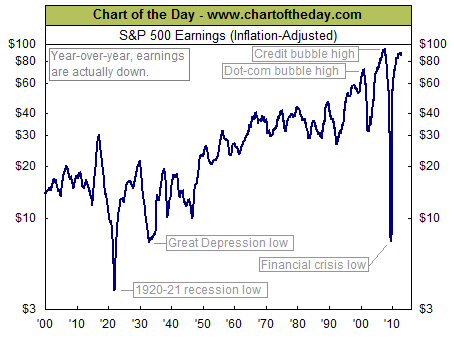Since the depths of the financial crisis in early 2009, the Dow Jones Industrial Average has soared 105%, rising from 6,627 on March 2, 2009 to a recent high of 13,610 on October 1, 2012. At the bottom in early 2009, most investors were contemplating the collapse of the entire U.S. financial system and the resulting panic drive stock prices to what, in hindsight, were bargain levels. As the Dow recently crossed 13,000, most stock analysts are bullishly proclaiming that further gains are in store for investors.
What drove the Dow up by over 100% and how likely is it that investors can look forward to further gains?
Fundamentally, the price of a stock represents the discounted present value of the future stream of earnings and dividends. As can be seen in the chart below, the stock market was propelled upwards since 2009 by a massive surge in corporate earnings that approached the all time high reached just prior to the financial meltdown of 2008-2009.
Despite the recent surge in consumer confidence to the highest level since September 2008, some analysts with great track records are predicting slow economic growth for the foreseeable future along with a reduction in corporate earnings. Carmen Reinhart and Kenneth Rogoff, who completed a massive analysis of the aftermath of financial crises and credit bubbles, are predicting a decade of sub par economic growth. From Barron’s:
Reinhart: The advanced economies, the United States included, really have not seen a crisis of this depth and breadth since the 1930s. In terms of its onset, it harks back to a lot of the liberalization of the financial systems in the advanced economies that enables a lot more risk-taking. And part of that risk-taking gets reflected in significant private-debt buildup. When we talk about having a debt overhang, it is not just about public debt, but also significant private debt, household debt, bank debt, domestic debt, and external debt. So this buildup began to show itself as an asset-price bubble, importantly in real estate—though that is not unique to this crisis. This is something that culminates with a lot of poor lending decisions, which became a banking crisis.
Rogoff: We circulated a paper in 2007 that plotted some of these key macroeconomic indicators, and we said, “Here are the worst financial crises since World War II.” We said it was clear that the U.S. would be lucky, given all of the indicators, to escape having a deep financial crisis. So, compared with other post-World War II financial crises around the world, this one is very typical, regardless of whether you compare it with the very small number of advanced-country crises or to the broader number of emerging-market crises. When it comes to this kind of a financial crisis, we as a country are not so different [than other countries]. That was a shock to us, because we are used to seeing emerging-market data be wildly more volatile than advanced-country data.
Rogoff: Again and again, policy makers, Wall Street economists, and world leaders have all been overly optimistic about how fast things are going to go. If you think that we are about to get a V-shaped recovery, then you talk yourself into forbearance. If you think, “My gosh, this is going to last 10 years, but how can we make it last seven years?” you say, “This is really painful, but we’ve got to do it.” But they’ve been very slow coming around to the view that this downturn isn’t ending soon, and they can’t just hold their breath and have it go away.
Look at Europe. A lot of policies are directed at keeping European banks afloat, and it is crippling the credit system. You could have said the same about the U.S., where a lot of policies are about recapitalizing the financial system. The policy makers were very, very cautious about breaking eggs. The thinking was, “We just have got to hold out for a year, and it is going to be fine.”
According to Rogoff and Reinhart, debt levels of households, financial companies and government remain at dangerously high levels which will continue to impede economic recovery. If Rogoff and Reinhart are even half right, future stock returns are likely to be extremely subdued going forward.

Speak Your Mind